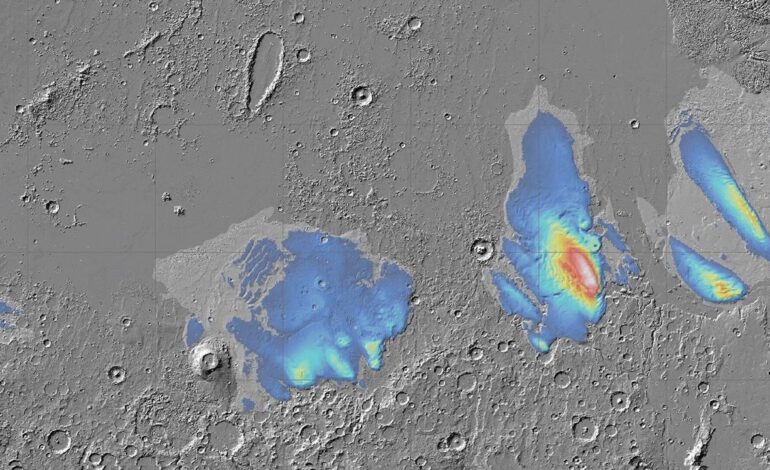Explosive Volcanism on Mars May Reveal Hidden Ice Deposits

Ancient volcanic eruptions on Mars may account for unexpected signs of buried ice at the planet’s equator, according to a recent study published in the journal Nature Communications. Scientists have long known that Martian ice deposits are primarily found at the poles, much like on Earth. However, new data from the Mars Odyssey and the ExoMars Trace Gas Orbiter has revealed elevated levels of hydrogen in the equatorial regions, raising questions about the presence of ice in these areas.
Researchers suggest that if this ice exists, it could have been preserved under layers of dust or volcanic debris, potentially remaining hidden for millions of years. The study’s lead author, Saira Hamid, a planetary scientist at Arizona State University, noted that one hypothesis for the formation of this ice relates to volcanism. Explosive eruptions could have released significant amounts of water vapor into the Martian atmosphere, which may have subsequently frozen and fallen as ice.
Simulation Findings Point to Ice Formation
The researchers utilized computer models to simulate explosive volcanic eruptions that are believed to have occurred on Mars between 4.1 billion and 3 billion years ago. Their findings indicate that a single eruption lasting just three days could produce ice deposits reaching up to 16 feet (5 meters) thick near a volcano. Hamid emphasized the potential cumulative effect of repeated eruptions, stating, “Imagine how much ice could be delivered after repeated eruptions over the course of millions of years.”
This research offers a potential explanation for the elevated hydrogen signals detected near the Martian equator. While Hamid cautioned that the hydrogen might not solely indicate the presence of ice, as it could also originate from various minerals, future studies could search for signs of ash-covered ice to validate these findings.
Implications for Future Exploration
If ice pockets do exist in the equatorial regions of Mars, they could hold significant value for future human exploration. Hamid highlighted the importance of volcanic regions as potential high-priority targets for exploration efforts. In addition to providing resources, these areas could also offer insights into the planet’s geological history.
The study also suggests that ancient volcanic activity may have contributed to a cooler Martian climate by releasing sulfuric acid into the atmosphere. This process could have generated sunlight-reflecting aerosols, leading to a global winter that allowed ice to accumulate over extended periods. Furthermore, this volcanism might have created transient environments conducive to life. Hamid stated, “Those regions might have offered transient but potentially life-supporting conditions.”
Understanding the origins and locations of these ice–ash deposits could be crucial in the search for past or preserved biosignatures on Mars. The implications of this research are significant, as scientists continue to explore the potential for life on the Red Planet while considering the practical needs of future missions.






